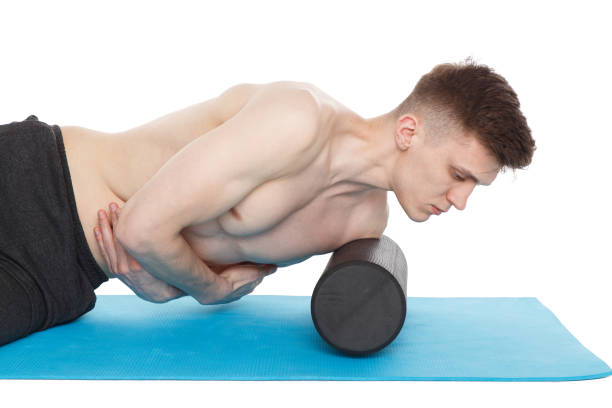Body movement Therapy
Get Ready to Rock Your Yoga Practice for Frozen Shoulder
Are you battling with a frozen shoulder and searching for relief? Look no further: in this article, we’ll show you how to conduct yoga for frozen shoulder, which can provide long-term relief and restore your complete range of motion.
Frozen shoulder, also known as adhesive capsulitis, can be exceedingly debilitating, causing stiffness and pain that makes even basic chores difficult. Yoga, with its gentle stretches and emphasis on breath control, can be a very effective and natural technique to relieve frozen shoulder symptoms and recover flexibility.
In this comprehensive tutorial, we’ll look at a variety of yoga poses meant to target and relieve tension in the shoulder joint. From simple stretches to more advanced asanas, we’ll provide step-by-step directions and pictures to help you practice safely and confidently at home or in a studio.
Whether you’re an experienced yogi or a complete beginner, our expert suggestions and modifications will help you tailor the practice to your specific needs. So, prepare to roll out your mat and go on a journey of healing and pain-free mobility!

Understanding Frozen Shoulder
Frozen shoulder, also known as adhesive capsulitis, is a disorder that causes discomfort and stiffness in the shoulder joint. It happens when the tissues surrounding the shoulder joint inflame and thicken, causing the joint capsule to constrict. This leads to reduced mobility and a severe decrease in range of motion.
The actual origin of frozen shoulder is unknown, but hormone imbalances, diabetes, and a history of shoulder injuries or operations may all raise the risk. The condition usually advances in three stages: freezing, frozen, and thawing. Each stage can last many months, resulting in a lengthy period of discomfort and limited mobility.
Benefits of Yoga for Frozen Shoulder
Yoga has several benefits for people who have frozen shoulders. Gentle stretching and strengthening activities promote blood circulation and flexibility in the shoulder joint. Yoga also promotes relaxation and stress reduction, which can help relieve the tension and discomfort caused by frozen shoulder.
Regular yoga poses for frozen shoulder can help increase range of motion, alleviate pain, and improve overall shoulder function. It can also help improve strength and avoid future shoulder issues. Yoga also promotes body awareness and mindfulness, helping people to form a stronger connection with their bodies and better comprehend their limitations and strengths.
Precautions Before Starting
Before beginning a yoga practice for frozen shoulder, speak with a healthcare provider, especially if you have any underlying medical concerns or are recuperating from a recent shoulder injury or surgery. They can offer personalized advice and recommendations based on your specific needs.
It is also critical to listen to your body and avoid pushing yourself beyond your capabilities. Begin slowly, then progressively increase the intensity and duration of your practice. If you encounter pain or discomfort while performing a pose, alter it or stop immediately. Remember that yoga should never cause discomfort, and you must prioritize your safety and well-being.

Yoga Poses for Frozen Shoulder
Now, let’s look at a few yoga positions that can aid with frozen shoulder symptoms and encourage healing. Remember to move thoughtfully and with awareness, focusing on your breath and ensuring perfect alignment during each posture.
Warm-up Exercises
Start your practice with gentle warm-up exercises to prepare your shoulder joint for deeper stretches and movements. These exercises help increase blood flow, warm up the muscles, and loosen any tightness in the shoulder area.
- Neck Rolls: Sit or stand with your spine straight. Slowly lower your chin to your chest and turn your head to the right, placing your right ear near your right shoulder. Continue the circular motion, moving your head back and to the left to complete a full rotation. Repeat in the opposite direction. This exercise relieves tension in the neck and upper back, which indirectly benefits the shoulders.
- Arm Circles: Stand with your feet hip width apart. Extend your arms out to the sides, shoulder height. Begin moving your arms in small circular motions, gradually increasing the size of the circles. After a few spins, change directions. This exercise warms up the shoulder joint and increases its range of motion.
- Shoulder Rolls: Stand with your feet hip width apart. Relax your arms at your sides. Roll your shoulders forward gradually, pushing them up towards your ears, pinching them back, and finally releasing them down. Reverse the motion by rolling the shoulders back, up, forward, and down. This exercise relieves tension in the shoulder area and increases mobility.
Gentle Stretches
After warming up, it’s time to move into gentle stretches that target the shoulder joint and surrounding muscles. These stretches help lengthen and release tension in the muscles, improving flexibility and reducing stiffness.
- Cross-Body Arm Stretch: Sit or stand with your spine straight. Extend your right arm out in front of you to shoulder height. Position your left hand on the outside of your right arm, just above the elbow. Pull your right arm across your chest slowly until you feel a stretch in your right shoulder. Hold for 30 seconds to one minute, then switch sides. This stretch helps to loosen up the shoulder joint and improve mobility.
- Thread the Needle: Start on all fours in a tabletop position. Extend your right arm to the side at shoulder height and reach beneath your left arm, threading it through the gap between your left arm and knee. Lower your right shoulder and right side of head to the mat. Hold for 30 seconds to one minute, then switch sides. This stretch works the muscles in the upper back and shoulders, reducing tension and increasing flexibility.
- Eagle Arms: Sit or stand with a straight spine. Extend your arms out in front of you, shoulder height. Cross your right arm over your left arm, bringing your palms together. If possible, wrap your right forearm over the left forearm, bringing your hands back together. Lift your elbows slightly and pull your shoulders back from your ears. Hold for 30 seconds to one minute, then switch sides. This stretch opens up the shoulder joint, extends the upper back muscles, and increases range of motion.

Strengthening Exercises
In addition to stretches, incorporating strengthening exercises into your yoga practice can help rebuild muscle strength and stability around the shoulder joint. These exercises gradually increase the load on the muscles, promoting healing and preventing future injuries.
- Downward Dog with Shoulder Activation: Begin in a plank position, wrists directly under shoulders and body in a straight line. Press your hips up and back to get into a downward dog pose. As you push into your hands, envision spreading the floor apart with your palms to activate your shoulder muscles. Hold for 30 seconds to 1 minute, concentrating on the contraction of your shoulder muscles. This exercise improves the muscles in the shoulders and upper back, increasing stability and support.
- Plank with Shoulder Taps: Start in a plank position, wrists directly under shoulders and body in a straight line. Lift your right hand from the mat and tap your left shoulder. Return your right hand to the ground and continue on the opposite side, touching your right shoulder with your left hand. Continue alternating sides for 30 seconds to a minute. This workout focuses on the muscles in the shoulders, arms, and core, increasing total strength and stability.
- Wall Push-Ups: Stand facing a wall about an arm’s length away. Place your palms against the wall at shoulder height, little wider than shoulder width apart. Step your feet back to form a diagonal line from your head to your heels. Bend your elbows and drop your chest towards the wall while maintaining a straight line. Push back up to the starting position. Repeat for 10 to 15 times. This workout builds up the muscles in the chest, shoulders, and arms, increasing stability and support.
Tips for Practicing Yoga with Frozen Shoulder
When practicing yoga with frozen shoulder, it’s important to keep a few key tips in mind to ensure a safe and effective practice:
- Modify as Needed: Listen to your body and make modifications to the poses as necessary. Use props such as blocks or straps to support your practice and adapt the poses to your current range of motion and comfort level.
- Focus on Breath: Pay attention to your breath throughout your practice. Deep, mindful breathing helps relax the body and mind, allowing for greater ease and comfort in the poses.
- Take Breaks: If you start to feel fatigued or experience discomfort, take breaks as needed. Rest in child’s pose or any comfortable position, allowing your body to recover before continuing.
- Stay Consistent: Consistency is key when practicing yoga for frozen shoulder. Aim for regular, shorter sessions rather than sporadic, lengthy ones. This will allow your body to gradually adapt and improve over time.

Other Complementary Therapies for Frozen Shoulder
In addition to yoga, there are other complementary therapies that can enhance the healing process and provide relief for frozen shoulder. These therapies can be used alongside yoga or as stand-alone treatments, depending on your preferences and individual circumstances. Some popular options include:
- Massage Therapy: Regular massage treatments can assist to reduce muscle tension, boost blood flow, and promote relaxation, all of which lead to better shoulder mobility and pain reduction.
- Physical Therapy: Seeing a physical therapist who specializes in shoulder rehabilitation can be quite beneficial. They can walk you through particular exercises and strategies to increase your range of motion, strength, and stability.
- Acupuncture: This ancient Chinese technique involves inserting small needles into particular places on the body to facilitate energy flow and healing. Acupuncture has been demonstrated to alleviate discomfort and enhance range of motion in people who have frozen shoulder.
- Heat and Cold Therapy: Applying heat or cold to the afflicted shoulder helps relieve inflammation, discomfort, and improve circulation. Use a heating pad, heated towel, or ice pack as prescribed by your healthcare provider.
- Medication: To control pain and inflammation, over-the-counter or prescription drugs may be advised. Consult your healthcare expert for appropriate solutions depending on your individual circumstances.
Conclusion
Yoga can be an effective therapy in the treatment and recovery of frozen shoulder. Gentle stretches, strengthening exercises, and focused breathing can help you relieve discomfort, increase flexibility, and recover full range of motion. Remember to practice mindfully, listen to your body, and get help from a healthcare expert if necessary. With determination and consistency, you can find relief and begin a road toward healing and pain-free movement.
Trusted Health, Wellness, and Medical advice for your well-being


